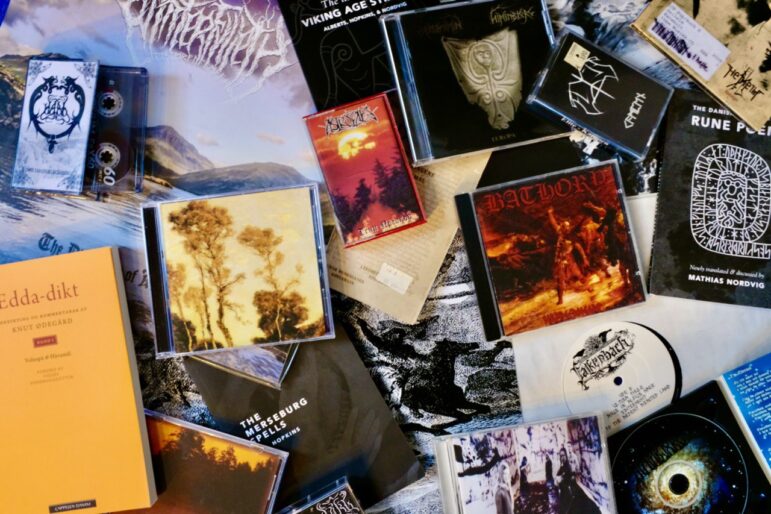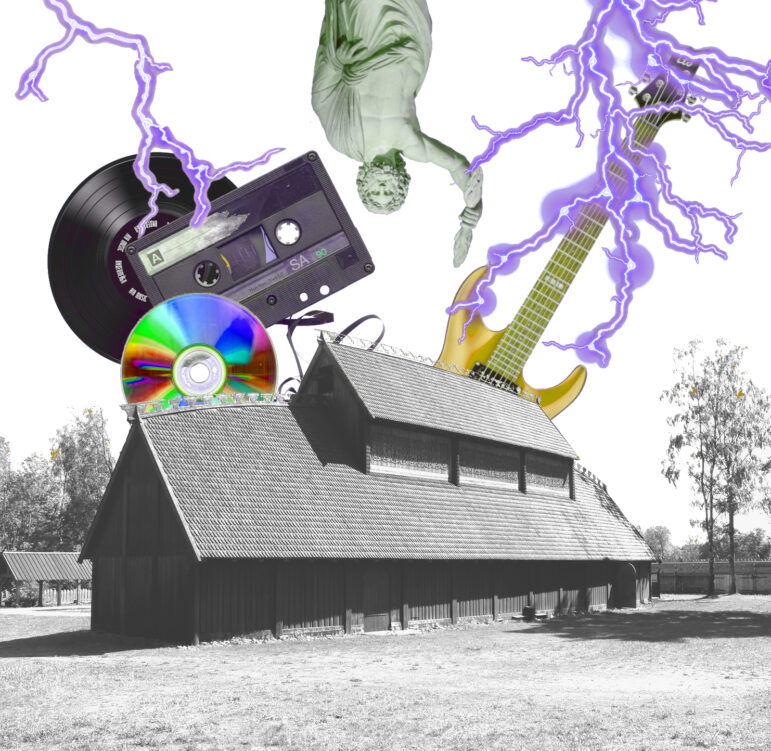
In a previous article, I wrote about my discovery of Pagan metal and how it fundamentally altered the way I conceive art and spirituality. While I hope it was an entertaining and instructive piece, I realized halfway through that explaining and presenting the genre more in detail would be a good way to engage the readership and maybe even convince some people to giving it a try.
I therefore present our readers an (over)-simplified and beginner’s friendly guide to Pagan metal and its associated subgenres, in the hope that readers will give it a chance – and hopefully find at least one song you like in the playlist which concludes this article.
A Simplified History of Paganism in Metal
While Pagan themes have been present in rock music since the late 60s and early 70s (at least), these generally remained few and far between. When heavy metal took off in the 80s, a number of bands soon started to utilize pre-Christian myths and imagery but never from the standpoint of religious belief and practice – Manowar being here the best example.
Arguably the first metal band which seriously explored Pagan themes was the late 80s UK thrash metal band Sabbat. After two albums that explored, among other things, pre-Christian spirituality and myth, the band’s singer and lyricist Martin Walkyier left Sabbat to form Skyclad. That new band soon stood out for its heavy use of acoustic guitars, fiddles, and flutes and other folk instruments alongside traditional metal instrumentation. Skyclad thus became one of the first band to be described as playing folk metal.
At the same time, in Sweden, Thomas Börje Forsberg, better known under the name of Quorthon, was pivoting his band, Bathory, away from a Satanic and occult imagery toward one inspired by Norse mythology. In doing so, he likewise altered the band’s music, producing longer, more melodic mid-tempo tracks where keyboards and folk instruments aided in establishing a grand, dramatic atmosphere. Bathory’s three albums released between 1988 and 1991 were later considered as having established yet another subgenre, namely Viking metal.
In the years that followed, a new generation of metal musicians, largely inspired by Bathory’s pre-Viking music, crafted the harsh sound of what would later be known as the second wave of black metal. Almost immediately, however, and particularly in Scandinavia, a number of these newly-established bands started to incorporate heavy Pagan imagery and themes in their releases. Some of these even started to embrace some of the musical elements pioneered by Quorton during his band’s Viking phase, thus developing yet another subgenre, Pagan metal.

A pile of Pagan metal records and Pagan books (photo by the author)
Sonic Characteristics of Three Subgenres
Now that we have gone (at light speed) through the early history of these styles, it may prove useful to quickly describe their overall sound more thoroughly. Keep in mind, however, that the way I choose to describe and ascertain certain characteristics to these subgenres is admittedly subjective and, once again very simplified.
In this small corner of metaldom, taxonomy is less a science and more a philosophy, where once you disentangle one musical thread, a bunch more knots come out. This is such a complex topic that there has even been academic papers written about it.
With that in mind, here is a short cheat sheet to folk, Viking, and Pagan metal.
Folk metal
Folk metal is characterized by the central part acoustic/folk instruments take in just about every song. While fiddle/violin, acoustic, and classical guitars, as well as all types of flutes are by far the most common to hear, there is virtually no limits when it comes to instruments. Unsurprisingly, folk metal bands often borrow melodies, lyrics, and other musical forms from various old-timey popular and traditional musical genres such as various national folk music traditions, sea-shanties, polka, and more.
In relation to heavy metal as a whole, folk metal is versatile: listeners can find bands that merge the aforementioned folk influences into just about every subgenre, such as black or symphonic metal. Often, however, folk metal bands will stick to a solid base of traditional heavy/power metal, thus making their music relatively accessible to those who do not care much for the most aggressive side of metal.
Folk metal bands, while they often make reference to ancient folklore, do not necessarily base their lyrical concepts and aesthetics upon Paganism and mythology. Many, if not most, are more influenced by heroic fantasy and ancient history in general than by Paganism. Due to the incredible diversity in traditional folk music, one can also find numerous sub-subgenres within folk metal, such as Celtic metal, klezmer metal, Oriental (that is, Middle Eastern) metal, Native American folk metal and more.
Viking metal
Viking metal was, as established earlier, pretty much engineered from the ground up by Quorthon of Bathory, who released no less than six albums in that subgenre between 1988 and 2003. Although Bathory started out as a harsh black/thrash metal band, Quorthon later adopted a sound closer to traditional heavy metal as well as doom metal, a subgenre which was beginning to take hold in his native Sweden at the time.
Bathory’s Viking metal is characterized by long, often mid-tempo tracks where guitars alternate between layers of heavy atmospheric sound, folksy arpeggios, and outrageous solos. The heavy use of choirs and keyboards, which give the whole thing a more dramatic and evocative feel, also adds a melodious aspect to the music that at times is almost even catchy.
Since Quorton, and Bathory’s, untimely death, however, the moniker of Viking metal has been applied to a flurry of bands that do not follow this aforementioned formula to any extent, as long as that they sing about rowdy Norse pirates. Nevertheless, the musical heritage of Bathory lives on through bands that tend to calque the dramatic atmosphere of their idol unto a more traditional mold of heavy/power metal, mostly focusing on melodies, vocal harmonies, and the use of keyboards rather than on folk instruments.
Pagan metal
While Viking metal took the Bathory formula closer to traditional heavy metal, Pagan metal instead seized it and delved deep with it into the depths of extreme metal, taking particularly strong cues from second wave black metal.
The result is an often complex mixture, solidly anchored on metal elements such as shrieking vocals, fast drumming and guitar playing, but with an atmospheric twist. Tracks tend to be long, sometimes taking cues from ambient music or progressive rock (sometimes both), and some bands incorporate traditional, folk, and acoustic instruments as well.
What brings this at times disparate assembly of musical influences and sub-subgenres is the desire to create unequivocally Pagan art using heavy metal as a matrix for both cohesion and sonic experimentation. If many folk and Viking metal bands are less than serious about their lyrical contents and aesthetics, you can be sure as Hel that Pagan metal bands are not, regardless if they sound more like a lo-fi garage noise act or King Crimson.

A Note on Politics
While the vast majority of Pagan, Viking, and Folk metal bands are apolitical by design, some bands, or some of their members, have been known to publicly taken stands on social and political issues. As is the case with neo-folk, some have at times associated themselves with right wing or far-right-wing ideas. Mileage may vary, but for someone to whom the political stances of artists they listen to is a point of contention, I would advise consulting the Metal Archives, the online heavy metal encyclopedia, which lists just about every bit of information about every metal musician and every metal band, including all of their releases. In many cases, entries also include information about each band’s lyrical concept as well as sometimes lyrics themselves.
The Mix
The following mix is a blend of various songs from Pagan/Viking/folk metal bands that I like and which I feel give a good overview of what these subgenres are about. This list is, it must be noted, 100% subjective: this is not intended as a definitive Pagan/Viking/folk metal playlist, but rather as a curated list from artists I am familiar with. There are a ton of other bands out there that could have made it into the list, but even I am not aware or into each and every Pagan-y metal band there is.
The current list is organized chronologically, with songs released between 1994 to 2019, in case listeners might want to witness the evolution of the (sub)genre(s), but I feel like this mix could just as well be enjoyed on shuffle.
I hope anyhow that you will give it a try and hopefully even discover one new song or artist that will be to your liking, and may this be but the first step in your Pagan metal journey.
The Wild Hunt is not responsible for links to external content.
To join a conversation on this post:
Visit our The Wild Hunt subreddit! Point your favorite browser to https://www.reddit.com/r/The_Wild_Hunt_News/, then click “JOIN”. Make sure to click the bell, too, to be notified of new articles posted to our subreddit.